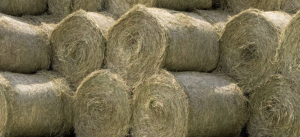 Minimizing wastage in round hay bales stored outdoors has many advantages. Hay for horses traditionally comes in two forms: square bales (usually rectangular) that weight about 40 to 50 pounds, or larger and much heavier round bales. Round bales have advantages and disadvantages compared to smaller square bales. Cost, availability, and the need for less covered storage may be good points, while detractions include necessity of a tractor to move the bales and probability of having some hay wasted during both storage and feeding.
Minimizing wastage in round hay bales stored outdoors has many advantages. Hay for horses traditionally comes in two forms: square bales (usually rectangular) that weight about 40 to 50 pounds, or larger and much heavier round bales. Round bales have advantages and disadvantages compared to smaller square bales. Cost, availability, and the need for less covered storage may be good points, while detractions include necessity of a tractor to move the bales and probability of having some hay wasted during both storage and feeding.
As much as 35% of the hay in an improperly stored round bale can be lost because of degradation from weather and contact with the ground, according to an article appearing in the September 2014 University of Minnesota Horse Newsletter. The article offered the following tips for storing round hay bales so that waste can be kept to a minimum::
- Dense, tightly compacted round bales will keep their shape well and therefore have less surface area contacting the ground.
- Round bales secured with plastic twine or netting generally have less dry matter loss than those baled with traditional string twine.
- Round bales stored outside should be placed on wooden pallets or a raised pad of at least four inches of coarse rock. Bales should not be stored under trees.
- Round bales should be placed end to end in lines at least three feet apart. This protects the ends of bales and allows airflow and sunlight to help keep bales dry. Avoid stacking bales, as this traps moisture.
- Protecting round bales with heavy plastic tarps or storing the bales indoors can significantly cut losses due to weather and moisture.
